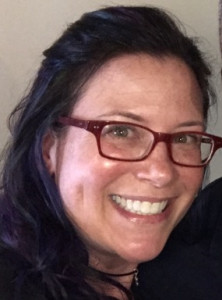
Therapy Tips 
 The following are some materials that I have found helpful when preparing for yoga sessions:
Yoga for the Special Child: A Therapeutic Approach for Infants and Children with Down Syndrome, Cerebral Palsy, Autism Spectrum Disorders and Learning Disabilities by Sonia Sumar
YogaKids: Educating The Whole Child Through Yoga by Marsha Wenig (Author), Susan Andrews (Photographer)
Mindful Games: Sharing Mindfulness and Meditation with Children, Teens, and Families by Susan Kaiser Greenland
Yoga 4 Classrooms Activity Card Deck Cards by Lisa Flynn (Author), James Vaughn (Illustrator)
Yoga Pretzels (Yoga Cards) Cards by Tara Guber (Author), Leah Kalish (Author), Sophie Fatus (Illustrator)
Yogarilla Exercises and Activities—Yoga Flash Card Deck by Super Duper Educational Learning Toy for Kids
Woodstock Solo Silver Zenergy Chime by Eastern Energies Collection
Original Hoberman Sphere, Rainbow by Hoberman
The following are some materials that I have found helpful when preparing for yoga sessions:
Yoga for the Special Child: A Therapeutic Approach for Infants and Children with Down Syndrome, Cerebral Palsy, Autism Spectrum Disorders and Learning Disabilities by Sonia Sumar
YogaKids: Educating The Whole Child Through Yoga by Marsha Wenig (Author), Susan Andrews (Photographer)
Mindful Games: Sharing Mindfulness and Meditation with Children, Teens, and Families by Susan Kaiser Greenland
Yoga 4 Classrooms Activity Card Deck Cards by Lisa Flynn (Author), James Vaughn (Illustrator)
Yoga Pretzels (Yoga Cards) Cards by Tara Guber (Author), Leah Kalish (Author), Sophie Fatus (Illustrator)
Yogarilla Exercises and Activities—Yoga Flash Card Deck by Super Duper Educational Learning Toy for Kids
Woodstock Solo Silver Zenergy Chime by Eastern Energies Collection
Original Hoberman Sphere, Rainbow by Hoberman
Yoga for Special Needs: Is It a Good Option for Your Child?
Yoga is growing in popularity as an adjunct to traditional therapies that are used with children who have special needs. Yoga differs from traditional speech therapy, physical therapy, occupational therapy, and ABA (applied behavioral analysis) in that it “treats the whole child” versus working on a single system. I have been a practicing speech and language pathologist for over 20 years. I originally started to investigate using yoga as an addition to my current work as a method of improving core stability and breath control in order to improve or increase speech production. Yoga has proven to be an effective method for improving these skills. However, to my surprise, yoga has a profound effect on many more areas of a child’s development.Connections
My initial yoga teacher training was given by Sonia Sumar, who is the founder of Yoga for the Special Child. The theme of her training was developing a “soul to soul” connection. Yoga for the Special Child differs from traditional therapies, as the practitioner is taught to see a child with a disability as a whole person versus a set of limitations requiring rehabilitation. Practitioners are taught to begin each session without expectations and let the child join the instructor in his or her own time. Teachers of Yoga for the Special Child focus their time on bonding with the child. Although asana (sequence yoga poses) is important, it almost becomes secondary to developing trust and connection. According to a study conducted by NYU Steinhardt researcher Kristie Koenig, a 16-week yoga regimen resulted in a significant decrease in aggressive behavior, social withdrawal, and hyperactivity for autistic students attending District 75’s P. 176X in the Bronx. Students in this study engaged in the Get Ready to Learn yoga program designed by Anne Buckley-Reen, pediatric occupational therapist and yoga therapist. The use of programs such as Get Ready to Learn is growing in popularity in schools today. Children in my yoga classes often report that they have practiced some of the techniques I am introducing in their classrooms, mindfulness classes, physical education classes, or recess.Reduced Stress
Participating in regular asana practice has been shown to reduce cortisol levels. This is an extremely important benefit, as increased cortisol levels have an impact on individuals' health in a variety of ways. Increased cortisol levels have been linked to lower immune function, weight gain, and heart disease. It impacts learning and memory. Chronic stress and elevated levels of this stress hormone increase risk for depression and mental illness. For children with disabilities, studies show elevated cortisol levels in situations that would be considered benign by their typically developing peers. Furthermore, it is suggested that chronic stress and cortisol levels rise as children get older. Research on practicing yoga and its impact on reduction of chronic stress and cortisol levels is limited. However, studies are starting to show that children who have participated in regular yoga instruction including breathing exercises, asana (yoga postures), meditation techniques, and relaxation are showing both lower salivary cortisol levels and improved performance on behavioral rating scales.Self-Acceptance
The practice of yoga teaches students to accept their body and its limitations. Yoga teaches a set of guidelines called yamas and niyamas. As students participate in yoga classes, they are exposed to the principles discussed within these yamas and niyamas. Children are taught a variety of concepts including, but not limited to, kindness, non-violence, honesty, respect, generosity, living in moderation, healthy living, and peace. Yoga programs such as ChildLight yoga incorporate children’s literature and related movement activities to teach children how the yamas and niyamas apply to everyday life. Through participation in yoga classes, students are taught to accept their body for what it can do today. Participants are taught to focus on their own practice and not to compare themselves with others in the class. Many classes focus on teaching students to identify what makes them unique, celebrate their strengths, and accept their current weaknesses.What to Look For in a Yoga Instructor
Compared to traditional therapies, the world of yoga is less regulated, leaving consumers with the difficult task of finding an instructor who meets the needs of their family. You may need to try a few different programs before choosing an instructor who is a proper fit. As a general rule, I would suggest working with a yoga instructor who has some formal training in teaching a children’s class. Be honest about your child’s special needs, and talk to the instructor about the program he or she is currently offering. You may want to find an instructor with some background in working with individuals with special needs. However, this is not necessarily a requirement. The best advice I can give here is to “go with your gut.” Look for an instructor who takes the time to try to get to know you and your child, has created an environment that is warm and accepting, and is open to working together with you to provide your child with a positive experience.What to Expect of a Yoga Program
Yoga differs from traditional therapy in that it is a way of life versus a rehabilitation program. This may be a difficult adjustment for families. Because my background is in speech pathology, I have needed to adjust the way I approach yoga students as well. When beginning a yoga program, you'll need to let go of the idea of specific targets, time frames, and expectations. Yoga is not the type of program that a family should begin with the thought that their child will take 10 lessons and end the program with a specific set of new skills. Beginning a yoga program with that mind-set will likely lead to disappointment. Children may choose not to participate but rather just listen. Non-participation is acceptable within a yoga program, as the instructor understands that children absorb information in different ways. As a consumer, you may be tempted to ask the instructor questions like, “How long does a child typically participate in yoga before desired results are achieved?” Again, those who practice yoga engage in it as a practice over the course of a lifetime. There is no such thing as a yoga expert. Yoga instructors are also considered students of yoga. Yoga should never be considered a replacement for any necessary traditional therapies. Rather, the practice of yoga may prepare your child’s system to receive greater benefit from the education or therapies they are currently receiving. When trying to determine if a yoga program is the right fit for your child, I would consider the following:- Does your child enjoy the program?
- Do you see any evidence that your child is gaining any of the following: confidence, a sense of calm, joy, strength, flexibility, coping strategies, improved focus, improved connection, or improved ability to trust?



